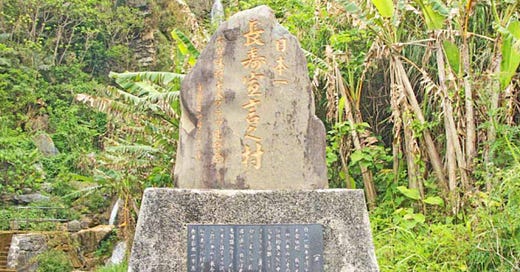Sitting along highway #58 in the small seaside village of Ogimi is a stone marker.
That marker has a special inscription on it … one that reflects what it’s like to live in the village.
Now changes are you’ve never heard of Ogimi.
It’s located about 1,000 miles from Japan on the remote island of Okinawa.
There aren’t many people who live here. The population sits roughly at 3,232 residents.
Yet it’s been the center of a medical mystery so profound that scientists, journalists, and other health professionals have been flocking to this small village for years to study what's happening here.
You see what makes this little village truly amazing is that currently 15 people living here are centenarians (people 100 years old). One hundred and seventy-one are in their 90’s. And over one quarter of the residents are over the age of 65.
Even in Japan, which has more than 70,000 people aged 100 or older, so many people living such long lives in one area is nothing short of a miracle. In fact more older people live in Ogimi than any other place in the world.
And because of this, it’s been called the Village of Long Life. And they’re proud of what they’ve accomplished, which is why the stone marker reads:
At 80 years old, I am still a child. When I come to see you at 90, send me away to wait till 100. Let us keep going strong as we get older, and not depend too much on our children in old age. Come to our village in your old age, and we will provide the blessings of nature and teach you the secrets of longevity. We the senior citizens of Ogimi proudly declare this the longest-lived village in Japan."
Super Healthy Too
Here’ something else worth noting about the Ogimi residents – they not only are living longer but 80% of its older citizens live independently, requiring no nursing home care.
Cancer and cardiovascular diseases in the village is much lower than the worlds average. Additionally, osteoporosis and hip fractures are half the rate here in the U.S.
So what’s the key scientist have uncovered that make Ogimi a longevity hot spot?
American gerontologist Dr. Craig Willcox who has spent the past 47 years studying the residents of Omigi says part of it comes from a healthy lifestyle. The other part is genetics.
Although he has not specifically studied the genetics of the residents, longevity sure seems to run in families there.
They Are What They Eat
But and this is important, Dr. Willcox also says it comes from what residents eat.
The Omigi diet, also known as chouju-zen (longevity food) consist of vegetables, soy, legumes and fish. It’s a diet that nutritionist say is nutritionally dense yet light in calories.
Fish is so important to the residents of this small town; they eat a half serving every day.
This probably doesn't surprise you. After all, Japanese people are well known for eating lots of seafood. But it’s what kind of seafood and how much they eat that is astonishing.
According to The Food and Agriculture Organization of the United Nations, Japan imports more seafood than any other country. It also consumes 6% of the world’s fish harvest including a significant chunk of all salmon, shrimp, and crab.
Tiny Nutrients
You see, there’s a critical super nutrient that’s found in trout, lobster, crab, shrimp, and salmon. It’s called astaxanthin (pronounced “Asta-zan-thin,”) and salmon have the highest concentrations of all animals.
It's what gives them their pink coloring.
This nutrient comes from the micro-algae the salmon feed on. It’s what gives them the strength they need to swim upstream, against powerful waters, traveling anywhere from 700 to 1,000 miles during their spawning season.
In a study published in the Journal of Agricultural and Food Chemistry, researchers discovered that astaxanthin has superior anti-aging properties.
Another study showed astaxanthin had "demonstrable promise for slowing age-related functional decline.”
Not only could it improve life expectancy, but it also helps you look younger. That’s based on a report from the National Institutes of Health, which showed that astaxanthin actually aides in preventing wrinkles and sagging skin.
In addition to eating lots of fish, Ogimi residents also eat a lot of fruits, sweet potatoes, seaweed, and green leafy vegetables. Villagers refer to the foods they eat as “nuchi gusui,” which means let food be your medicine.
A Laid Back Lifestyle
It also helps that the little island where they live is different from the rest of Japan. The climate is sub-tropical with mild winters. They live amid scenic beauty. For instance, behind the stone marker, and tucked away in the trees, you’ll find a waterfall.
Residents are known for being mellow and laidback. And older residents are treated with respect and sense of purpose. Everyone is supportive of one another, which allows them to develop emotional connections within groups of residents.
Scientists agree being connected is definitely linked to living longer. Dr. Willcox says, “Loneliness is as a bad for you as smoking.”
So what’s the good idea we can learn from the residents of Ogimi …
If you want to live longer, start eating more fish, fruits and vegetables and live a more relaxed lifestyle. In other words, start being more Japanese. Who knows you could live to be 100.
Awesome Quotes by Awesome People
“In the end, long life is the reward, strength and beauty.” — Grace Paley




